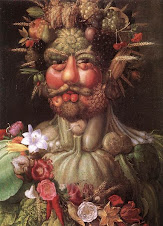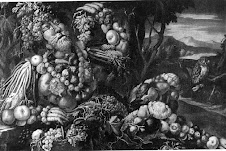Sunday, July 27, 2008
Pot Worms in the Worm Bin
In the last 6 months, I've noticed a curious growth of tiny white creatures in my redworm bin that I, at first, mistakenly took for baby worms. They actually are pot worms and "bloom" in the bin when the soil becomes acidic. Baby redworms (Eisenia fetida) have a red vein running down the length of their bodies within hours after birth, so if you're seeing a bunch of tiny, undulating, white lines, they are probably pot worms. Opinions are mixed as to whether they are bad to have in a bin, but I have seen the amount of food being digested in my bin double since they moved in, so I don't mind them at all! In fact, Happy D Ranch says Pot Worms are good for my compost system, which I can believe. I did question how they would impact my garden when I work in the vermicompost (there is no chance you could separate these guys out of the castings/compost). According to All About Worms, "pot worms won’t harm other living worm species, they do no damage to living plants either. Their diet is strictly bacteria and fungus." However, the pot worms plus the mites are indicating that my bin is probably getting too acidic. That means no more coffee grounds and more eggshells.
Saturday, July 26, 2008
Worm Bin Friends (or Foe?)
I'm harvesting the vermicompost out of my worm bin today to give my garden and indoor plants an extra boost. Every time I dig deep into that bin I see things I never wished to see in my house. At least they stay in the bin. This time it was a million little red mites. Mites are common in worm bins, but are these particular ones benign or bad news? My worm flier from Happy D Ranch (my pets' birthplace) says the red ones could be parasitic to the worms, but the other sources I've found say they don't cause problems. I do know why their population exploded recently- the bedding is too wet. I added dry shredded paper today and took out the tasty treat for the mites (pineapple chunks), and removed a lot that were sitting on the pineapple. Too bad, because worms like those fleshy fruites too. Guess i'll have to stick to less fleshy, drier vegies in the bin for a while.
Friday, July 18, 2008
Local vs Organic
I've recently had a difficult decision to make regarding my dairy products: is local better than nationally certified organic? Royal Crest Dairy is a Colorado company that will deliver to my house weekly for a cheaper price than store bought organic. I was told that while not certified organic, they are rBGH- and antibiotic-free and raised to organic standards. They are also pasturized, versus ultra-pasturized, which helps with my mozarrella making! My big question was animal treatment, and I was told that they can't let the dairy cows graze all day because they will get stomach aches from weeds, but the woman in charge "takes them out and pets them three times a day". Haha! So i know from the Cornicopia study that Organic Valley milk I currently buy is pretty good in regards to animal treatment and is purchasing milk from local farmers, but there is no such study done on small, local farms (that I know of). Maybe I need to take a field trip up to the farms, but I think seeing milk production in action, organic or not, might be disturbing. For now, I will give Royal Crest a try and hope that they are as good as Organic Valley. If nothing else, they reuse their bottles and now I have a milk man!
Tuesday, July 15, 2008
Earwigs

Yuck! Can't think of a bug that creeps me out more than an earwig. My lettuce is finally bolting, and as I pulled it all out of the ground yesterday (was able to get one last, gigantic bowl full!), I found tons of earwigs running around their roots. While earwigs have been known to eat things in the garden I want to eat, it sounds like they might be doing more good than harm. "They eat weeds and weed seeds. They eat the eggs and larvae of root maggots, cutworms, aphids and hundreds of other insect pests—indeed, they bolt down any critter they can physically overwhelm. They even convert your decaying plant material to the organic matter your Western soil so dearly needs." Guess i can put up with them for that! Also, they are one of the few known insects to actually demonstrate maternal care for the young. Awww, how sweet.
Monday, July 7, 2008
Cherokee Chocolate
Oh boy, the Cherokee Chocolate tomato plant might be in trouble. Tonight, its leaves were all curled up like the plant needed water. The leaves were crispy looking and paler in color than their neighbors. But the soil was moist and the tomatoes surrounding it are fine, which would suggest its not a water problem. I'm afraid that this baby might have the Curly Top Virus, apparently common in western Colorado and with no remedy. I watered tonight and will see if the plant is better in the morning. If not, I will probably have to remove it from the garden so the crazy beet leafhoppers don't spread it to other tomatoes and peppers.
In other tomato related news, I broke down and bought yet another tomato plant at the nursery yesterday! Tried so hard to grow Brandywine seeds, then later to track down Brandywine plants at the farmers market - so couldn't pass up my luck to find one 30% off at the local nursery :) Now just need to find a good spot. . .
In other tomato related news, I broke down and bought yet another tomato plant at the nursery yesterday! Tried so hard to grow Brandywine seeds, then later to track down Brandywine plants at the farmers market - so couldn't pass up my luck to find one 30% off at the local nursery :) Now just need to find a good spot. . .
Labels:
Brandywine,
Cherokee Chocolate,
Curly Top Virus,
Tomatoes
Saturday, July 5, 2008
Oregon Sugar Pod Peas
Our Oregon Sugar Pod Peas have suddenly burst into production. The night we left town, I walked out and found a dozen 2 inch pods dangling off the vine where, earlier that morning, I swear there had been none. Returning a week later, there were dozens more and they are now 3 -4 inches long and bulging with peas! I've heard they taste just as delicious skinny with barely visible pods, or fat with plump peas, but I need to pick them soon, as the U of Illinois Extension Service says "Sugar snaps left on the vine too long begin to develop tough fiber in the pod walls." If anyone knows the best way to harvest these, please let me know. (How much of the stem, if any, do you pull off with the pea?) I don't know that we will have these with us for too much longer, given that they don't like summer heat, so we've got to enjoy them now! And I am definitely planning to try a fall crop.
PS - did anyone know that peas have been around since almost 10,000 BC?!! Check out the history of the pea.
PS - did anyone know that peas have been around since almost 10,000 BC?!! Check out the history of the pea.
Spring Crops
Today I officially ended my spinach harvest. Pulled out the whole plants (Bloomsdale and Maropa) and cut off the remaining leaves, most of which were little tiny pointy guys from the bolting process. Also pulled out the whole cilantro plants - going to seed as well and i'm not trying to harvest coriander. Overall, didn't get a big crop from either - think they just need to be put in the garden earlier than my community garden can turn on the water. But will definitely try to grow Bloomsdale next year (pot on porch?) since the it has such a rich, delicious flavor.
The cilantro is in a vase of water by the window - hopefully that will keep it fresh until we use it all. We made a Tasty breakfast of huevos rancheros this morning with the spinach and a bit of the cilantro.
Somehow, miraculously, the lettuce in the garden is still growing like gangbusters! It is in the 90s outside, and we are still harvesting. Most of it is under the romanesco brocolli, whose leaves have reached a 3 foot radius (no, I'm not exaggerating). Even the lettuce in the sun though is still going. Looking at the package, the variety in full sun is Grand Rapids which is described as "slower to bolt than other loose-leaf varieties". Nate likes this varierty, but i'm not so crazy about its taste - kind of tastes like dirt to me! Not sure I'll grow it again, but fun to be harvesting lettuce well into July.
The cilantro is in a vase of water by the window - hopefully that will keep it fresh until we use it all. We made a Tasty breakfast of huevos rancheros this morning with the spinach and a bit of the cilantro.
Somehow, miraculously, the lettuce in the garden is still growing like gangbusters! It is in the 90s outside, and we are still harvesting. Most of it is under the romanesco brocolli, whose leaves have reached a 3 foot radius (no, I'm not exaggerating). Even the lettuce in the sun though is still going. Looking at the package, the variety in full sun is Grand Rapids which is described as "slower to bolt than other loose-leaf varieties". Nate likes this varierty, but i'm not so crazy about its taste - kind of tastes like dirt to me! Not sure I'll grow it again, but fun to be harvesting lettuce well into July.
Labels:
Cilantro,
Lettuce,
Spinach,
Spring Crops
Back
Back in town and the garden still looks great, thanks to watering by a diligent sister in law! The fertilizer from last week seems to be helping - the peppers have a lot of new growth and the basil looks great. Weeds, however, have taken over! I spent 1 1/2 hrs yesterday weeding and got through 1 1/2 of 4 blocks. Got my work cut out for me this weekend. . . Happy 4th!
Labels:
Basil,
Pepper,
Square Foot Gardening,
Weeds
Subscribe to:
Posts (Atom)




